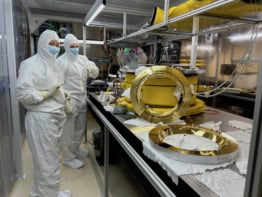Astronomers may have discovered a new class of gamma-ray bursts that are more powerful than supernovae but much weaker -- and more common -- than most "ordinary" gamma-ray bursts found so far. The claims are made by two separate teams of researchers, who used the INTEGRAL satellite to study a gamma-ray burst that was observed on 3 December 2003 (Nature 430 646 and 648). The results suggest that there is a continuum of cosmic explosions ranging in energy from supernovae to gamma-ray bursts.

Gamma-ray bursts (GRBs) are the most powerful explosions in the universe, but continue to baffle scientists over 30 years after they were first discovered. Most gamma-ray bursts are even brighter than the massive supernovae explosions that occur when a star dies and collapses to form a black hole. However, some astronomers believe that gamma-ray bursts and supernovae are in fact related. Although most supernovae do not have enough energy to produce gamma rays, the additional energy could be supplied by material falling into the black hole.
Now there is new evidence that gamma-ray bursts and supernovae could be related. On 3 December 2003 a gamma-ray burst lasting about 30 seconds was detected by the European Space Agency’s INTEGRAL satellite in a small galaxy about 1.6 billion light years away. A record 18 seconds after the start of the burst — named GRB 031203 — its location on the sky was sent out by the automatic burst alert system on INTEGRAL. Although the burst initially looked like an ordinary gamma-ray burst, the astronomers later found that it had an energy of about 0.6-1.4 1043 Joules, which is a thousand times lower than a typical high-energy burst.
This result was even more unexpected given that GRB 031203 is only the second closest gamma-ray burst ever to be found. The previous closest burst, which was discovered in 1998, was also found to be very faint, although astronomers were not sure if it was some sort of “freak” explosion. Now, however, the two teams of researchers — one from the US and the other from Germany and Russia — think that both bursts belong to a completely new population of gamma-ray bursts that lie somewhere in energy between supernovae and other gamma-ray bursts.
“Our discovery of GRB 031203 suggests that there is a significant population of sub-energetic gamma-ray bursts that we do not typically see since they are below our detection thresholds,” says Alicia Soderberg, a graduate student from the California Institute of Technology who is a member of the US team and lead author of one of the Nature papers. “GRB 031203 was only detectable since it was so nearby and suggests that sub-energetic gamma-ray bursts may in fact be more common than high energy counterparts.” The finding also rules out the idea that all gamma-ray bursts have the same energy.
Future missions dedicated to the detection of gamma-ray bursts — like SWIFT, which will be launched by NASA in October — might be able to detect many more events like these. “It will be interesting to see whether low energy events are more frequent than ordinary high-energy ones and whether there is a continuous distribution of gamma-ray burst energies,” adds Sergey Sazonov, a member of the Russia-Germany group at the Space Research Institute in Moscow and the Max Planck Institute in Garching.



